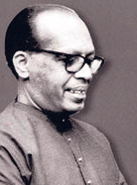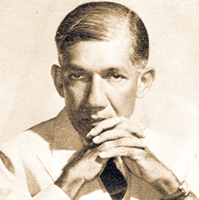Why most prefer to join the Public (Government) Service is for security. While their salaries are not as high as those working in the Private Sector, the
security comes in the form of a pension after
retirement. That means a fair share of the salary one earns just before
retirement (either at 55 or 60 years) is paid until that person dies, as a monthly pension.
Fifty years ago,
employees in the Private Sector did not have any form of such security. It was not until 1958, that they received some form of redress for their future after retirement.
 |
| T. B. Ilangaratne |
On November 28, 1958, the Employees' Provident Fund (EPF) was established under Act No. 15 of 1958.
It was the brainchild of the Labour Minister T. B. Ilangaratne in the
S. W. R. D. Bandaranaike government which swept to power in 1956.
Today, the EPF is the largest social security scheme in Sri Lanka with an asset base of
Rs. 560 billion as at December 2007,
equivalent to 25% of the GDP (Gross Domestic Product).
The EPF offers a joint action plan by the employer and the employee to save for the future retirement life of the employees in the Corporate and Private Sector. The aim of the EPF is to prudently manage the Fund to ensure a better return to the
members at retirement.
It brings peace of mind for the employees of institutions and establishments of the Private Sector,
State – Sponsored Corporations, Statutory Boards and Private Business. The aim of the EPF is to assure financial stability to the employee in the winter of life and to reward the employee for his or her role in the economic growth of the country.
The EPF ensures a safe and stable future for
persons who work in the above mentioned sectors. The Administrative aspect of the EPF is handled by the Labour Department of Sri Lanka whilst the management of the funds is handled by the Central Bank. A separate division called the EPF Department has been set up in the Central Bank for this purpose.
According to the EPF Act, an employee is required to contribute a minimum of 8% and the employer a
minimum of 12% of the total salary of the employee monthly. Each person's EPF balance keeps growing as the years move on because the Central Bank invests the funds in numerous government investment avenues like Treasury Bills, Treasury Bonds, Equity, Corporate Debentures and Rupee Securities.
Depending on the rate of return, an annual interest rate is declared and credited to each person's account. Thus the person and his or her family and the loved ones are assured of a stable and peaceful life after
retirement.
Although money in the EPF cannot be removed until the person retires, other facilities are provided during his period of service. For example, a housing loan can be obtained by placing 3/4th of the current balance as security.
An employee is entitled to membership in the EPF from the first day of his employment. It is the employer's responsibility to enroll the employee in the EPF and the employee can persuade the employer to do so.
Irrespective of the nature of the job, all employees should be enrolled whether they are permanent,
temporary, apprentice,
casual or shift workers. Employees working on piece rate, contract basis,
commission basis, work
performed basis or any
manner whatsoever are
eligible for membership.
Regardless of the nature and the category of the
business, an employer of even one employee is legally bound to pay contributions to the Fund.
Road in memory of D. R. Wijewardene
On November 26, 1965, the road McCallum Road was re-named 'D. R. Wijewardene Mawatha' in honour of the pioneer in the newspaper business in Sri Lanka. Earlier, the road had been named after Sir Henry McCallum,
governor from 1907–13.
 |
| D. R. Wijewardene |
The road was selected for the change because the Associated Newspapers of Ceylon Ltd. (ANCL) (referred to as Lake House because of its location on the edge of Beira Lake), which Wijewardene
founded, is situated down this road which stretches from the end of one side of Fort to Maradana.
It is customary for
public roads in a country to be named after prominent personalities in that country.
Looking at the names in the city of Colombo, during the
colonial administration most roads were named after British governors who administered the country from time to time. A few names used during the Dutch period are still in vogue. Hulftsdorp which houses the courts complex is one. General Hulft had his forces stationed on the Aluthkade hill. The courts buildings, however, were constructed by the British.
After gaining Independence, the road names gradually began to be changed. Most of them were re-named after prominent Sri Lankan
persons. Naming or
re-naming roads is decided by the local authority. In the case of Colombo, it is the Municipal Council that makes the decision. Generally a member would propose a name in the form of a motion before the Council and very often no one objects. |


